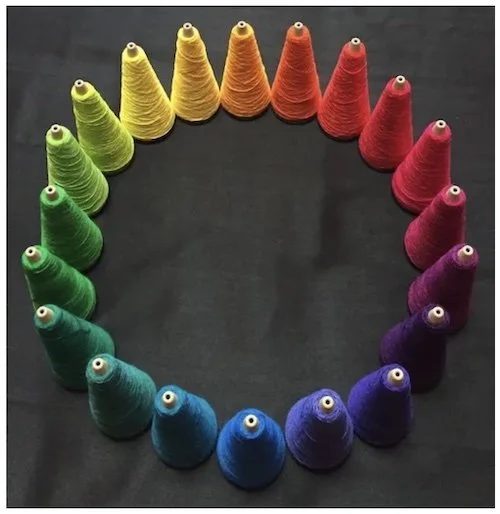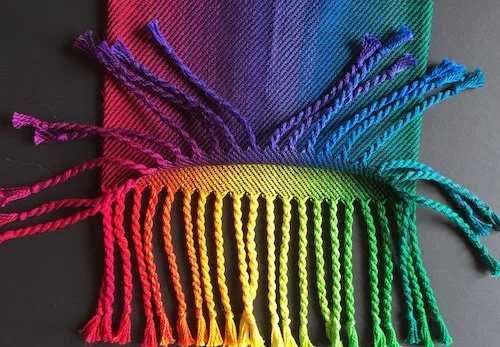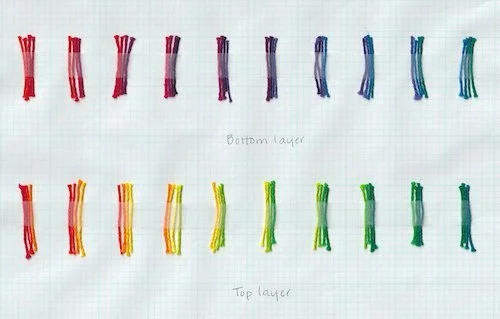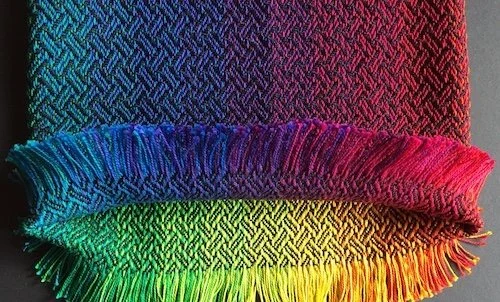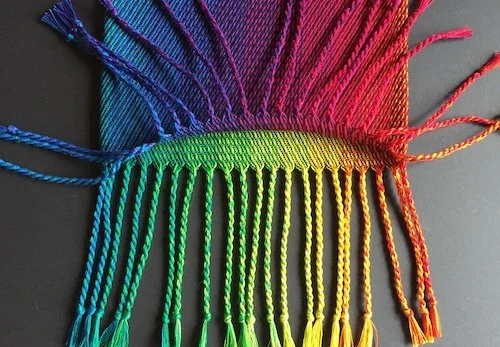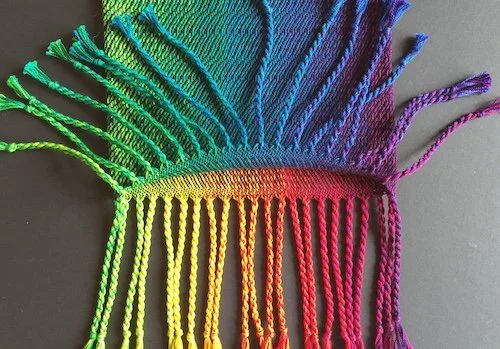Going Totally Tubular
What is it that compels me to start a new weaving project? Sometimes it is because there is something specific that I want to make for a specific reason. Sometimes I want to weave samples to illustrate a concept that I will be teaching about in a workshop. Sometimes just looking at all the colors of yarn in my studio makes me want to do something fun with them. And sometimes an idea enters my mind and I just want to find out what would happen if I tried it out.
I’ve been working a lot with the 20 original colors of the Lunatic Fringe Tubular Spectrum over the past few years and I have them arranged in a continuous circle in my studio.
It was probably inevitable that at some point the thought would occur to me - “Hey, I’m working with a rotation of the Tubular Spectrum in a continuous circle. And I’m working in doubleweave. And you can weave a continuous tube in doubleweave. I wonder how it would be to weave the tubular spectrum of colors in a doubleweave tube?”
So of course I had to try this out. The main challenge was figuring out the logistics of winding the two layers of warp and getting everything in the right order in the best possible way. I ended up taking two different approaches and found that each way had its advantages and that both ways worked.
For the first one I worked in 5/2 perle cotton in two layers of 4-shaft straight twill. The approach that I used for moving from one color to the next around the circle was to have a half-inch warp band of color 1, then a half-inch band alternating color 1 and color 2, then a half-inch band of color 2, and so on. I plotted out the arrangement of the two layers on graph paper so that I could wind the two warps together, winding four threads at a time.
I wound the doubled warp onto the back beam of my trusty 8-shaft Gilmore floor loom and used the graphed plan as a guide to follow in threading the heddles. Good light was key, particularly near the selvedges, since the colors are so close together and it was a challenge to distinguish one from another.
I used Fiberworks software to enter the 4-shaft straight twill threading and tie-up, and then used the Fold function to get the right threading and tie-up for a tubular structure.
I wanted a slightly warp-face sett and sleyed 4 threads per dent in a 10-dent reed to get a sett of 20 ends per inch in each layer. I added two ends of fishing line at each selvedge, one for each layer. They were threaded through the outermost two heddles along with a warp end and sleyed in the outermost threaded dent on each side. I weighted them off the back beam of my loom and hung 500 gram spools of linen yarn from each pair of fishing lines. These worked admirably to keep my selvedges nice and straight and to keep any draw-in from occurring at the two folds - see my blog ‘Weaving a Good Fold’ for a complete description on this technique.
I often like to use a weft yarn that is finer than the warp, as I find that it makes for a more supple textile with better drape. I used a black bamboo weft in a comparable weight to 10/2 cotton as a single weft throughout the weaving. With one shuttle going around and around from top layer to bottom layer the weaving went fairly quickly and smoothly. I wove up two scarves on that warp with the same structure and same weft.
For the next warp I switched to 10/2 perle cotton and tried out a different approach to moving through the colors in the warp. For this one I used my Double Rainbow color rotation system with four adjacent colors in each one-inch warp section, moving around the circle by shifting one color over in each new section. Since this meant that together the two layers would have eight colors being wound in a fairly complex sequence, I decided that it would be easier to wind each layer as a separate warp and beam them onto the loom separately.
Again I drew a graphed layout for each of the layers, but this time wound each layer separately, four threads at a time.
I was able to wind the two warps together onto one warp beam since they were the same yarn, but the crosses were held on two sets of lease sticks using my custom double-decker lease stick system, which I will describe in detail in my next blog.
I used my graphed layout to thread the heddles, alternating warp ends from the two sets of lease sticks. This time my sett was 32 ends per inch in each layer and was sleyed 8 ends per dent in an 8-dent reed.
First I tested out using an 8-shaft plaited twill on each layer, again using Fiberworks software to get the threading and tie-up for the two layers in a tubular structure. I used 20/2 black Venne cotton for the weft, which again was half the weight of the warp yarn. It came out well, but I decided that the cloth was a little stiffer than I wanted, and decided to try twills that would have better drape.
I switched to an 8-shaft straight twill on each of the layers and wove a scarf in this structure. We were in the midst of a heatwave while I wove this piece and I found that during the warmest part of the afternoon some of my shafts tended to stick and not rise up correctly. I figured out how to work with this challenge, but found a few skips in the pattern on the bottom layer when I took the piece off the loom - a disappointment since I really like the way this one came out otherwise.
For the remainder of the warp I thought I would try something a little different and set up an 8-shaft undulating twill on each of the layers, using the black 20/2 Venne as the weft again.
Altogether I ended up with four scarves woven in variations of a tubular twill structure. After washing and steam pressing them the fold lines are pretty darn good, and probably not very noticeable if you aren’t scrutinizing them.
This probably isn’t a particularly practical technique to use on a regular basis, but it was a good mental workout, a lot of fun, and well worth the effort.


